
Introduction and design
It can’t be debated that Alienware pioneered the gaming laptop scene. But fast forwarding 13 years finds the company up against tons of competition, all chomping at the bit to make the most souped-up machines that gamers will love.
What’s Alienware’s retort to the recent, excellent efforts from the likes of the Aorus X5, Razer Blade and HP Omen? Naturally, laptops that feature killer specs, like the latest Alienware 17. But the company also (hopes it) has an ace up its sleeve with the Alienware 13, parent company Dell’s latest 13-inch mid-range gaming laptop with a killer trick up its sleeve.
Is it the right gaming laptop for your tastes? It very well may be. A 13-inch chassis that’s thinner and lighter than ever makes it one of the more portable options out there. And the Broadwell Core i-series processor and Nvidia GTX 960M that come standard in each configuration makes it a tempting option if gamers are looking for near-console quality performance on the go.
But what else does it have to offer? The optional Graphics Amplifier that hooks into the back of the Alienware 13 can raise the graphical bar far beyond what it can accomplish alone. With it, you no longer need to replace the entire laptop whenever you want more up-to-date graphics hardware. It’s a huge perk, but it comes at almost the same price as the laptop itself.
If you’re the type of gamer who enjoys the experience of playing the latest games on the highest settings at 60 frames per second (fps), the Alienware 13 can’t do it without the help of the Graphics Amplifier. And while this laptop does pack a decent punch on its own, it isn’t the best value around for gamers.
Design
Technology has changed a lot since the launch of Alienware’s first gaming laptop 13 years ago. It has shrunk, become more efficient and cheaper to implement.
But even so, the overall shape and look of Alienware’s laptops have changed very little since the M17x of 2009. Sure, a large chunk of the heft has been lopped off, to everyone’s appreciation, but the plethora of LEDs and sharp edges you know and (maybe) love are here in full effect.
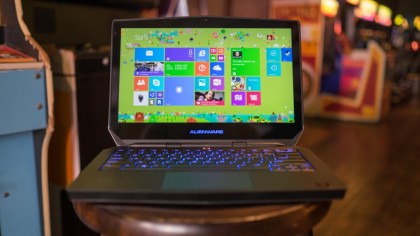
Does the design need an complete overhaul in the face of Ultrabook-rivaling gaming laptops, like the Razer Blade? If the stellar showmanship and excellent build quality of the Alienware 13 is any indication, maybe the company can still wring what’s left from the current blueprints for a few more years before going back to the drawing board.
As it sits on a desk, the “Epic Silver” lid echoes a similar design ID that flows through Alienware’s current line of computers. Just look at the design of the humongous Alienware Area 51 desktop to see what I mean.
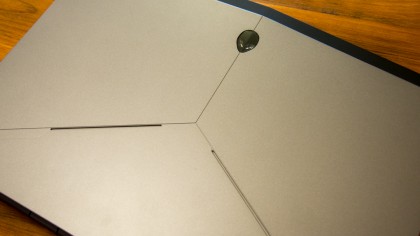
The lid’s narrow notches and the the little Alienware buddy light up with customizable patterns and look slick as usual. At the edges of the silver-speckled lid, the material style switches up, giving way to black, matte-textured plastic. It’s the same stuff that coats nearly all of the chassis. Connecting the lid to the body is a tough, plastic-coated hinge, which ensures a mostly wobble-free experience.
Compare the chassis of the Alienware 13 to the Alienware 17 and you’re bound to stumble across a few similarities in their design. Just like the 17, the lower section of the lid meets the body with an angular dip toward the hinge. You’ll also find the similar LED flourishes across the keyboard and on the lid and chassis, but that’s where the comparison ends.
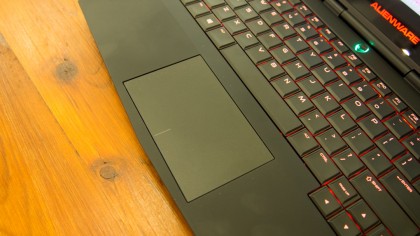
The Alienware 13 rocks a 81-key keyboard, which has the essentials covered but not much else. If the number pad is a necessity, consider hooking in an external keyboard. For everyone else, the caps covering each key are smooth and ever so slightly concave to the touch, which helps keeps fingers from slipping when the going gets tough (or when a round of gaming reaches its last, intense seconds.) The home keys each have an embossed lip jutting out to make no-look typing easier. And since this laptop is geared toward gamers after all, the “s” key has a mark of its own to allow a quick, seamless hop into WASD formation.
One of the design changes that I’m most psyched about with the Alienware 13 is the wider, centralized clickpad. Although it doesn’t light up, which might bum some people out, the new design ditches the physical buttons and makes for a much more sophisticated look. It sports all the same functionality as any trackpad you’re used to, but offers more tracking real estate.
Moving to the sides, Alienware didn’t go crazy with ports on the 13, but there’s enough here to satisfy those who need to plug in an external drive, as well as a mouse and keyboard. You won’t find any neat LEDs around these parts, as they are most likely the casualty of this computer’s fairly slim profile. It’s not a huge issue, as most will find the matte plastic to be a worthy fill in.
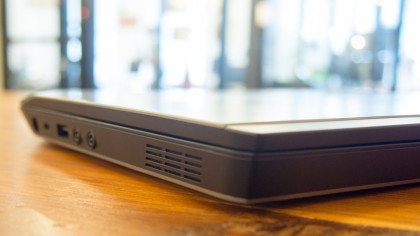
Near the wrist rests on each side, you’ll find what look like fan vents, but are actually openings to let sound out of the Klipsch-powered speakers. It’s a little weird that they were designed to fire out to the sides rather than toward the user, but at least they look – and sound – pretty good … for laptop speakers. Keep your 2.1 speaker system on hand, though, as these sound rather metallic.
All about AlienFX
Alienware computers have a leg up on the competition when it comes to customization. This is no different for the Alienware 13, which features more than a few LEDs that can be tinkered. The built-in Command Center app illustrates the lighting sectors of the machine and allows you to modify the colors and pulsation of each.
For example, you can set each sector of LEDs to a different color, give them their own, unique behavior (Morph, Pulse, or just display the color) and even tweak the tempo of each effect. The possibilities are limitless and can look as bonkers, badass or subdued as you choose.
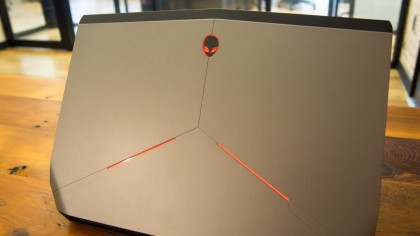
Of course, when you’re on the go, you might want to switch all, or just some, of the lights off to conserve battery. The Command Center makes that easy with power conditions. Each sector can be given an action for both when the Alienware 13 is plugged in and when it is sucking battery juice.
The app can also store several themes, so you can swap different lighting patterns out as you please. Some will dig these, others couldn’t care less. Either way, it’s here and it’s intelligently implemented, so it’s hard to complain even if it’s not your thing.
Specifications and value
The Alienware 13 has a shockingly small footprint for a gaming laptop. Even so, weighing in at 4.5 pounds (2.06kg), it’s just a tad bit heavier than some of the competition in its size range. The 14-inch Aorus X3 Plus v3 is somehow lighter at 4.12 pounds (1.87kg), while still packing in more hardware than the Alienware 13. The MSI GS30 Shadow weighs light as a feather by comparison at just 2.65 pounds (1.20kg). Despite being on the heavy end for a laptop of its size, its heft is offset visually by its sleek, slightly rounded-off edges.
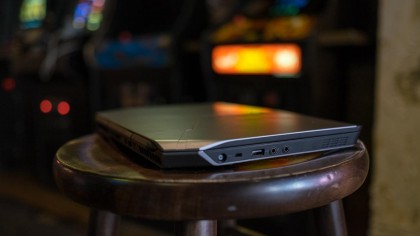
Measuring in at 12.9 x 9.3 x 1.09 inches (328 x 235 x 28mm), this Alienware laptop might be heavier than the X3 Plus and the GS30 Shadow, but it mirrors their slim dimensions much more closely. And, just like the other options, the Alienware 13 nixed the optical drive, making it small enough to fit snugly into most laptop bags and backpacks.
So, what was Alienware able to squeeze into the chassis? Here’s the configured Alienware 13 unit sent to TechRadar for review:
Spec sheet
- Processor: 2.4GHz Intel Core i7-5500U (dual-core, 4MB cache, up to 3.0GHz with Turbo Boost)
- Graphics: Nvidia GeForce GTX 960M (2GB GDDR5 RAM)
- Memory: 8GB DDR3L (1,600MHz)
- Screen: 13-inch, 2,560 x 1,440 QHD, anti-glare
- Storage: 256GB SSD
- Connectivity: Killer 1525 802.11ac, Bluetooth 4.1
- Operating system: Microsoft Windows 8.1 (64‐bit)
- Ports: Ethernet, USB 3.0 x 3, Mini DisplayPort, HDMI, headphone and microphone inputs
- Weight: 4.53 pounds
- Dimensions: 12.9 x 9.3 x 1.09 inches (W x D x H)
- Warranty: 1-year Alienware Limited Hardware; 10-14 day mail-in repair after remote diagnosis
What we’re looking at here is a slightly modified variation of Alienware’s $1,399 (about £1261, AU$1833) configuration, which is nearly the highest tier available. The Alienware 13 goes for as low as $949 (£948, AU$1,599) but can cost up to $1,649 (£1,198, AU$2,999) at the highest end. The configurations vary a bit between regions, but whichever bracket best represents your budget, you can rest easy knowing that its most alluring component, the Nvidia GeForce GTX 960M, comes standard.
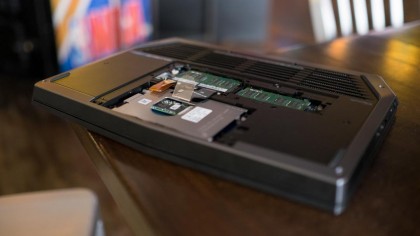
Electing for the highest tier over the lowest nets you the typical gains, like a switch from a spinning hard drive to a 256GB solid-state drive , a jump from Core i5 to i7 and doubling the RAM from 8GB to 16GB. But even the most juiced Alienware 13 has trouble stacking up to other gaming laptops in its size class.
This machine is limited throughout its four customizable tiers to dual-core processors and the GTX 960M with 2GB of video RAM, which just isn’t much for a gaming laptop in 2015. The Aorus X3 Plus v3 runs circles around it with its quad-core i7-4710HQ and the 970M, which packs a whopping 6GB of video RAM. Of course, this is portable gaming we’re talking about, so that’ll cost you $2,199 (around £1,346, or AU$2,742).
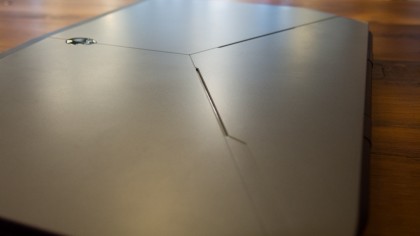
When looking at another option, the MSI GS30 Shadow, Alienware’s 13-inch laptop continues to be outpaced, but not by nearly as much. This MSI shares a common trait with the Alienware 13 in that it can also link up to an external graphical booster to enhance its output. But speaking just on the basis of what each laptop can offer out of the box, the MSI GS30 Shadow features a killer, quad-core i7-4870HQ processor and double the amount of RAM for around $1,500 (about £1355, AU$1,958) at the time of writing. But where the Alienware 13 wins in this matchup is with its dedicated graphics, one-upping the GS30 Shadow’s integrated solution, which is powered by Intel Iris Pro Graphics 5200.
At the $1,399 price range, the Alienware 13 has the advantage against the competition as being an affordable entry point to QHD gaming. The only problem that arises is when you attempt to game on this machine’s native resolution. It’s just not going to work well, but I’ll dive more into that later.
Graphics…Amplified!
The Graphics Amplifier is super cool. The concept of being able to plug into an external device to juice up your graphical experience as tech advances years down the line is a devilishly clever idea. But for $199 (£207, AU$349) for the enclosure alone at the time of writing, it’s not a cheap addition.
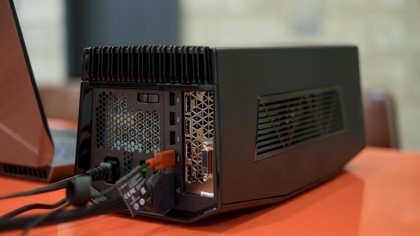
Again, that doesn’t even include the price of a graphics card that you’ll need to stock it with. We’re talking an extra $800 or so if you’re really going for the throat with an Nvidia GeForce GTX 980 or something comparable in the AMD realm of graphics cards.
Here is the Alienware Graphics Amplifier configuration given to TechRadar for review:
- GPU capacity: PCIe x16 Slot for desktop graphics card
- Graphics: PNY XLR8 GeForce GTX 980 (4GB GDDR5 RAM)
- Power supply: Alienware-approved, 460 Watt multi-GPU
- Ports: 4 x USB 3.0, Alienware Graphics Amplifier to Notebook Port
- Weight: 7.71 pounds (3.5kg)
- Dimensions: 7.3 x 16.12 x 6.83 inches (185 x 409 x 173mm, W x D x H)
How does the competition stack up now? The Aorus X3 Plus v3 doesn’t utilize a graphics amplifier. That’s because, frankly, with 6GB of vRAM, it doesn’t need one.
Looking at the GS30 Shadow, its screen powers down when plugged into the 16-pin PCI Express connector of its Gaming Dock. Also, when mounted on top of the printer-sized box, it’s also relatively out of reach at this point. So, you’d better have an external monitor, keyboard and mouse.
The Alienware 13, on the other hand, can resume its laptop utilities, just with the proprietary 4-pin PCI-E 3.0 cable coming from the Gaming Amplifier plugged discretely into its back.
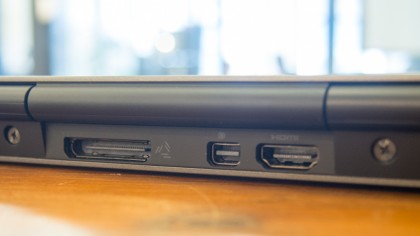
It’s hard to say which method is better for gamers, as each has its share of perks and flaws. MSI’s solution employs a standard 16-pin PCI-E connector, so it essentially incorporates the GS30 Shadow’s components as if they were all on a motherboard together. However, the laptop is totally out of reach when mounted on the Gaming Dock.
Alternatively, Alienware opted for a cleaner-looking, more versatile method, but it’s doubtful that the 4-pin PCI-E cable used with the Graphics Amplifier provides the uncompromised bandwidth required to fully siphon the power of the GTX 980 into the experience.
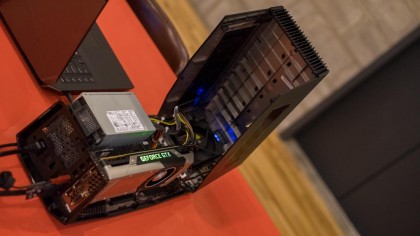
If the idea of the Alienware’s Graphics Amplifier appeals to you, it’s hard to blame you. But keep in mind that the overall performance of the Alienware 13 will only be as strong as its weakest link. I’m afraid that its dual-core, mobile Intel processor is a bitter bottleneck that might make you regret spending all of that money.
That said, the Graphics Amplifier is a handy solution for desktop-ifying the Alienware 13 with, you know, desktop-grade performance that most mobile chips have a hard time matching.
Performance and features
Out of the box, the Alienware 13 doesn’t create waves with its performance, but it’s more than enough to make for a satisfying experience when handling basic tasks, like surfing the web and playing high-resolution video. The Gaming Amplifier helps this laptop reach new heights in terms of gaming performance, but unfortunately, it only gets on by the skin of its teeth without it.
The laptop can play modern titles, like Middle Earth: Shadow of Mordor, at a very playable 44 fps at its lowest settings. Metro: Last Light’s benchmark is a sadistic test, and we use it for good reason: to see if gaming hardware can handle some of the most intense graphics available today. It didn’t fare as well with this game.
Here’s how the Alienware 13 performed with our benchmark tests:
Benchmarks
- 3DMark Cloud Gate: 10,362; Sky Diver: 9,913; Fire Strike: 3,462
- Cinebench CPU: 296 points; Graphics: 83 fps
- PCMark 8 Home: 2,408 points
- PCMark 8 battery life: 3 hours and 14 minutes
- Middle Earth: SoM (Ultra): 13 fps; (Low): 44 fps
- Metro: Last Light (Ultra): 10 fps; (Low): 21 fps
The ability to jack into the optional Graphics Amplifier is an extraordinary feat that, on paper, should be able to visibly enhance gaming performance. But does it? Let’s find out.
Benchmarks (with Graphics Amplifier):
- 3DMark Cloud Gate: 10,460; Sky Diver: 13,832; Fire Strike: 7,596
- Cinebench CPU: 297 points; Graphics: 87 fps
- PCMark 8 Home: 2,402 points
- Middle Earth: SoM (Ultra): 55 fps; (Low): 98 fps
- Metro: Last Light (Ultra): 26 fps; (Low): 55 fps
We’re getting much better performance here compared to the results sans Graphics Amplifier. But it’s easy to see how much of a hamper the dual-core processor (and that 4-pin connector) puts on things. Compared to the MSI GS30 Shadow, which features a quad-core i7-4870HQ, we saw performance gains five-fold over the initial output with its Gaming Dock.
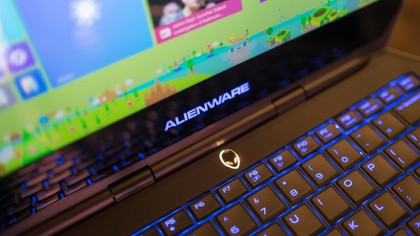
Buying into the most expensive configuration of the Alienware 13 and the Graphics Amplifier, stocked with a GTX 980, will cost roughly $2,400. So, you’d expect to be able to play just about anything on max settings, right? Wrong. Alienware isn’t painting too convincing a picture, with or without the Graphics Amplifier.
But if you’re just looking to get some light gaming on, especially to catch up on the hits of yesterday, the Alienware 13 is a fine choice. And whatever you’re running, the laptop is good at keeping cool.
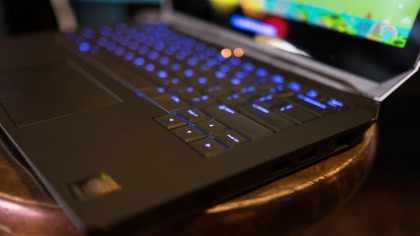
The fans kick right into gear when gaming gets intense or when I’m running a larger load of programs than usual, but the machine keeps quiet most of the time. It funnels heat toward its rear heat sinks, where the fans are located, so you’ll be OK to use this on your lap without frying your own hardware.
Mo pixels, mo problems?
The configuration sent to TechRadar is a modified variation of the $1,399 tier, which Alienware informed us is actually no longer available. However, it features all the same specs found in the current option, which you can check out on Alienware’s site if you’re curious. However, it comes with one interesting inclusion: a 2,560 x 1,440 touchscreen.
As predicted, this 400-nit IPS panel looks splendid, and the touch implementation works as expected for a Windows 8.1 machine, though it feels unnecessary. The internals can even run the gamut of applications without breaking a sweat. However, if you’re looking to game at this screen’s native resolution, you’ll need to first lower your expectations.
We run all of our gaming benchmarks at 1080p for the sake of consistency, but also because it’s the resolution that most of today’s gamers want to (or are able to) play on. And despite the inclusion of the QHD screen in the highest tier available of the Alienware 13, its dual-core i7 and GTX 960M can’t put up numbers worthy of including it in the first place.
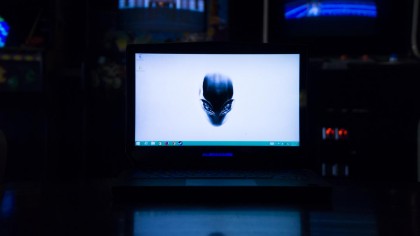
I played some of The Witcher 3: Wild Hunt and recorded my observations. Turning the settings up to ultra on its native resolution, the machine pushed out a consistent 9 fps. Notching things down to the lowest settings on its native, 2,560 x 1,440 resolution outputs a better, but still unplayable 22 fps.
Adjusting the resolution to 1,920 x 1,080 made a sizeable difference. On ultra, the Alienware 13 runs The Witcher 3 at about 14 fps. But on low, it can manage a pretty smooth 30 fps with dips in the lower twenties here and there.
Battery
Things look up for the Alienware 13 when battery life enters the conversation. PCMark 8’s battery test predicted that the battery can last up to 3 hours and 14 minutes. But the 52 watt-hour battery exceeded it slightly at three hours and thirty minutes on the balanced power setting, running at 50% brightness and all AlienFX lighting zones off in our anecdotal battery test. This involves stressing the machine with a combination of some relatively lightweight programs, like Spotify, internet chat and Google Chrome, until it runs out of juice.
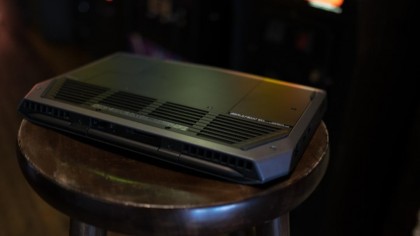
Against the competition, the Alienware 13 holds up exceptionally well here. The MSI GS30 Shadow powered down after 2 hours and 32 minutes under the weight of a comparable load of tasks. The Aorus X3 Plus v3 was able to provide roughly three hours of battery life. As usual, expect less than pleasing results with the battery inside the Alienware 13 if you’re gaming or working with intense applications.
Speaking of apps, the Alienware 13 didn’t come stocked with a lot of pre-installed software, thankfully. The few utilities here that did come pre-loaded make using the machine a little easier.
Bundled software
- AlienRespawn: This feature allows you to restore your Alienware machine with one click or back up your data.
- AW Command Center: You can customize the AlienFX lighting zones with this application.
- Alienware Digital Delivery: This app manages digital purchases and prompts you with a free 20GB of cloud storage on DropBox upon booting it up. Not bad!
Verdict
The Alienware 13 is a thin, attractive gaming laptop that enters the market at the aggressively low price of $949 to start. Alone, it can handle plenty of basic tasks and even a good share of the latest games at an acceptable clip, albeit tuned down almost all the way.
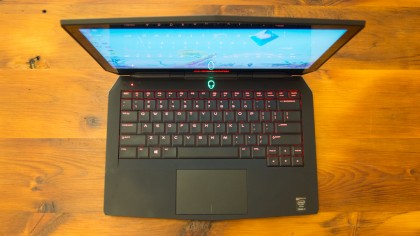
The Alienware 13 takes off graphically with the Graphics Amplifier plugged in, becoming somewhat of a future-proofed device in doing so. But this presents a dilemma for gamers. I can’t imagine that there will be many who are itching to spend up to an extra $800 to unlock the capabilities of something that already cost them close to $1,000, if not more.
We liked
The Alienware 13 isn’t the lightest gaming laptop around, but it’s a looker. The “Epic Silver” lid looks slick, the build quality is top-notch and the fully customizable LED detailing is a cool touch that you can only find on an Alienware.
Using the laptop is a joy from a usability angle. The ports offer up the flexibility to connect a few accessories and an external screen, if you choose to go down that route. Its keyboard is responsive and the trackpad, while finicky at times, generally provides a smooth experience.
I appreciate that gamers who opt for the low-end machine at $949 are treated to the capable GTX 960M graphics chip found in the rest of the configuration options.
The ability for gamers to upgrade the graphical capabilities of the Alienware 13 through the optional Graphics Amplifier adds value over the long term. Whereas most other gaming laptop owners will need to replace their machine outright when the next big game releases, Alienware 13 owners can scale with the games to come.
We disliked
But at a cost – like, a serious cost. The Alienware 13 makes good on coming in at $949, which is on the lower end of the price spectrum for a gaming laptop. But, once you tack on the Graphics Amplifier, along with a beefy GTX 980 like I tested out, the price tag skyrockets close to, or well over, $2,000.
Sure, cost is an issue if you choose to purchase the Graphics Amplifier. You don’t need to, but my problem is that it feels almost necessary. The relatively limited capabilities of the laptop’s internals makes it a little too obvious a nudge from Alienware to purchase the Graphics Amplifier.
Final verdict
By itself, the Alienware 13 is a fine laptop. It’s equipped with capable guts for a reasonable price (at least to start) that should keep players plenty entertained. That is, so long as they don’t mind knocking the graphical fidelity of games down to low in most cases.
If you won’t settle for anything lower than high settings, you’ll simply need to spend more money. There’s no way around it. The aforementioned Aorus X3 Plus v3 costs a fortune by comparison, but packs in a godly amount of video RAM and might be worth the price, if you’re a sucker for graphics.
If the idea of the Graphics Amplifier entices you, the MSI GS30 Shadow also has its own version. While more expensive than most configurations of the Alienware 13, the MSI GS30 Shadow comes with a much more capable quad-core processor (and true 16-pin connection) that really helps that laptop sing when attached to its Gaming Dock.
But if Alienware had its way, you’d just shell out for its Graphics Amplifier. It’s an attractive idea that works well, but it’s disappointing that the upgrade feels forced if, at the end of the day, even non-enthusiast gamers will be left wanting more out of the Alienware 13.
![]()
Related Posts
December 6, 2021
7+ Web Design Trends for 2022: Which Will You Use?
December 6, 2021
The 10 Best WordPress Booking Plugins to Use On Your Website
December 6, 2021
How to Use a Web Cache Viewer to View a Cached Page
November 6, 2021
10 Modern Web Design Trends for 2022
November 6, 2021
Best Free SSL Certificate Providers (+ How to Get Started)
November 6, 2021
How to Design a Landing Page That Sends Conversions Skyrocketing
November 6, 2021
What Are the Best WordPress Security Plugins for your Website?
October 6, 2021
Your Guide to How to Buy a Domain Name
October 6, 2021
How to Build a WordPress Website: 9 Steps to Build Your Site
September 6, 2021
10 Best Websites for Downloading Free PSD Files
September 6, 2021
HTML5 Template: A Basic Code Template to Start Your Next Project
September 6, 2021
How Much Does It Cost to Build a Website for a Small Business?
September 6, 2021
A List of Free Public CDNs for Web Developers
September 6, 2021
6 Advanced JavaScript Concepts You Should Know
August 6, 2021
10 Simple Tips for Launching a Website
August 6, 2021
25 Beautiful Examples of “Coming Soon” Pages
August 6, 2021
10 Useful Responsive Design Testing Tools
August 6, 2021
Best-Converting Shopify Themes: 4 Best Shopify Themes
July 6, 2021
What Is Alt Text and Why Should You Use It?
July 6, 2021
24 Must-Know Graphic Design Terms
June 6, 2021
How to Design a Product Page: 6 Pro Design Tips
April 6, 2021
A Beginner’s Guide to Competitor Website Analysis
April 6, 2021
6 BigCommerce Design Tips For Big Ecommerce Results
April 6, 2021
Is WordPress Good for Ecommerce? [Pros and Cons]
March 6, 2021
Make Websites Mobile-Friendly: 5 Astounding Tips
March 6, 2021
Shopify vs. Magento: Which Platform Should I Use?
March 6, 2021
Top 5 Web Design Tools & Software Applications
February 6, 2021
Website Optimization Checklist: Your Go-To Guide to SEO
February 6, 2021
5 UX Design Trends to Dazzle Users in 2021
February 6, 2021
What Is the Average Page Load Time and How Can You Do Better?
February 6, 2021
Choosing an Ecommerce Platform That Will Wow Customers
February 6, 2021
7 Best Practices for Crafting Landing Pages with Forms
February 6, 2021
7 B2B Web Design Tips to Craft an Eye-Catching Website
January 6, 2021
Mobile-Friendly Checker | Check Your Site’s Mobile Score Now
January 6, 2021
8 Tips for Developing a Fantastic Mobile-Friendly Website
December 6, 2020
How to Add an Online Store to Your Website [4 Ways]
December 6, 2020
5 UX Design Tips for Seamless Online Shopping
November 6, 2020
Ecommerce Website Essentials: Does Your Site Have All 11?
November 6, 2020
5 Small Business Website Essentials You Need for Your Site
November 6, 2020
Your Website Redesign Checklist for 2020: 7 Steps for Success
May 1, 2020
Psychology of Color [Infographic]
April 21, 2020
How to start an online store that drives huge sales
January 3, 2020
5 Lead Generation Website Design Best Practices
March 6, 2019
6 Reasons You Should Redesign Your Website in 2019
March 6, 2019
7 Web Design Trends for 2019
February 19, 2019
Who owns the website/app source code, client or developer
February 7, 2019
Don’t Let Your Domain Names Expire in 2019
January 8, 2019
2019 Website Development Trends To Note
October 6, 2017
How Web Design Impacts Content Marketing
October 6, 2017
How to Choose a Navigation Setup
August 6, 2017
Why User Experience Matters to Marketing
July 6, 2017
5 Ways Web Design Impacts Customer Experience
September 6, 2016
How to Learn Angular
September 6, 2016
The Excuses for Not Having a Website (Infographic)
September 6, 2016
How to Build an Award-Winning Web Design Team
September 6, 2016
13 Free Data Visualization Tools
August 6, 2016
How Selling Pastries Helped Us Design a Better Product
August 6, 2016
11 Sites to Help You Find Material Design Inspiration
July 4, 2016
How to change free wordpress.com url
April 6, 2016
The 5 Best Free FTP Clients
April 6, 2016
7 Free UX E-Books Worth Reading
March 6, 2016
Can Handwritten Letters Get You More Clients?
December 10, 2015
Star Wars Week: How to create your own Star Wars effects for free
December 6, 2015
20 "Coming Soon" Pages for Inspiration
December 6, 2015
6 Free Tools for Creating Your Own Icon Font
December 6, 2015
9 Useful Tools for Creating Material Design Color Palettes
November 6, 2015
20 Free UI Kits to Download
November 6, 2015
50 Web Designs with Awesome Typography
November 6, 2015
When to Use rel="nofollow"
November 6, 2015
7 Free Books That Will Help You Become More Productive
November 6, 2015
50 Beautiful One-Page Websites for Inspiration
November 6, 2015
Circular Images with CSS
October 6, 2015
Lessons Learned from an Unsuccessful Kickstarter
October 6, 2015
5 Games That Teach You How to Code
October 6, 2015
Cheatsheet: Photoshop Keyboard Shortcuts
October 6, 2015
An Easy Way to Create a Freelance Contract for Your Projects
October 6, 2015
50 Design Agency Websites for Inspiration
September 29, 2015
JB Hi-Fi shutting the book on ebooks
September 24, 2015
Opinion: Quick, Quickflix: It's time to give yourself the flick
September 24, 2015
New Star Wars 360-degree video is among first on Facebook
September 21, 2015
Apple purges malicious iPhone and iPad apps from App Store
September 12, 2015
Apple's new Live Photos feature will eat up your storage
September 12, 2015
The latest Windows 10 Mobile preview has been delayed
September 12, 2015
IBM buys StrongLoop to add Node.js development to its cloud
September 8, 2015
Fake Android porn app takes your photo, then holds it ransom
September 6, 2015
50 Restaurant Websites for Inspiration
September 6, 2015
Zero UI — The Future of Interfaces
September 6, 2015
50 Beautiful Websites with Big Background Images
September 6, 2015
Infographic: 69 Web Design Tips
September 6, 2015
Free Windows 10 Icons
September 2, 2015
Instagram turns itself into a genuine messaging service
August 11, 2015
In Depth: How Microsoft taught Cortana to be more human
August 11, 2015
Windows 10 price, news and features
August 11, 2015
Windows 10's broken update introduces endless reboot loop
August 11, 2015
Windows 10 races to 27m installs
August 11, 2015
Windows 10 IoT Core gets first public release
August 10, 2015
iOS Tips: How to backup iPhone to an external drive
August 10, 2015
Windows 8.1 RT finally getting Windows 10 Start Menu
August 10, 2015
How to use Windows Hello
August 10, 2015
Review: Moto Surround
August 10, 2015
Review: Moto G (2015)
August 9, 2015
8 of the best free VPN services
August 8, 2015
Use Firefox? Mozilla urges you update ASAP
August 7, 2015
Mac Tips: Apple Mail: How to remove the Favorites Bar
August 7, 2015
How to make the OS X dock appear faster
August 7, 2015
Review: BQ Aquaris E45 Ubuntu Edition
August 7, 2015
Review: Acer Liquid Jade Z
August 6, 2015
How to reinstall Linux
August 6, 2015
How to reinstall Windows
August 6, 2015
Updated: Apple Music: release date, price and features
August 6, 2015
Social News Websites for Front-End Developers
August 6, 2015
10 Free JavaScript Books
August 6, 2015
50 Beautiful Blog Designs
August 6, 2015
Animated SVG Pipes Effect
August 6, 2015
Launching Your First App
August 5, 2015
Windows 10 goes freemium with paid apps
August 5, 2015
Updated: Week 1 with Windows 10
August 5, 2015
Mac Tips: How to manage Safari notifications on Mac
August 5, 2015
Microsoft Sway may kill the PowerPoint presentation
August 4, 2015
Microsoft gives Outlook on the web a new look
August 4, 2015
Mac OS X vulnerable to new zero-day attack
August 4, 2015
Windows 10 users warned of two scams
August 4, 2015
Microsoft's Docs.com is now available to everyone
August 3, 2015
Mac Tips: How to edit the Favorites sidebar on Mac
August 3, 2015
Updated: Windows 10 price, news and features
July 29, 2015
Review: HP ProDesk 405 G2
July 29, 2015
Hands-on review: HP Elite x2 1011
July 29, 2015
Hands-on review: Updated: Windows 10 Mobile
July 29, 2015
Review: Updated: Nvidia Shield Android TV
July 28, 2015
LIVE: Windows 10 launch: Live Blog!
July 28, 2015
How to prepare for your upgrade to Windows 10
July 28, 2015
Review: Updated: Windows 10
July 28, 2015
Review: Updated: HP Pro Tablet 608
July 28, 2015
Review: Heat Genius
July 28, 2015
Hands-on review: Moto X Play
July 28, 2015
Hands-on review: Moto X Style
July 28, 2015
Hands-on review: Moto G (2015)
July 28, 2015
Review: 13-inch MacBook Air (early 2015)
July 28, 2015
Hands-on review: OnePlus 2
July 28, 2015
Review: LG 65EG960T 4K OLED
July 28, 2015
Mac Tips: How to share printers on Mac
July 27, 2015
Apple Music's arrival hasn't opened Pandora's box
July 26, 2015
Review: Garmin Swim
July 25, 2015
How to merge OS X contacts into an existing list
July 25, 2015
Hands-on review: UPDATED: ZTE Axon
July 24, 2015
Mac Tips: How to zoom in on a Mac
July 24, 2015
What Windows 10 means for the enterprise
July 24, 2015
Review: JBL Charge 2 Plus
July 24, 2015
Review: Acer Aspire S7
July 24, 2015
Review: Updated: Canon G3 X
July 24, 2015
Review: Updated: iPad Air 2
July 24, 2015
Review: Thinksound On1
July 24, 2015
Review: Asus Chromebook Flip
July 24, 2015
Review: Garmin Forerunner 225
July 23, 2015
Review: Garmin nuvi 68LM
July 23, 2015
Review: Samsung Galaxy S6 Active
July 23, 2015
Review: Bowers and Wilkins P5 Wireless
July 23, 2015
Review: Dell XPS 15 (2015)
July 21, 2015
Review: Fuji S9900W
July 21, 2015
Review: Updated: Fitbit Surge
July 21, 2015
Review: UE Roll
July 21, 2015
Hands-on review: Ubik Uno
July 20, 2015
Review: Samsung HW-J650
July 20, 2015
Updated: 40 best Android Wear smartwatch apps 2015
July 20, 2015
Review: Acer Chromebook C740 review
July 20, 2015
Review: Huawei Talkband B2
July 20, 2015
Review: Dell Venue 10 7000
July 20, 2015
Review: Intel Core i7-5775C
July 17, 2015
Mac Tips: How to delete locked files on Mac
July 17, 2015
Review: Pebble Time
July 16, 2015
Microsoft just made Windows XP even less secure
July 16, 2015
Windows 8.1 RT is getting an update this September
July 16, 2015
OS showdown: Windows 10 vs Windows 8.1 vs Windows 7
July 16, 2015
Review: Acer CB280HK
July 15, 2015
Windows 10 is ready for new laptops and PCs
July 15, 2015
Explained: How to take a screenshot in Windows
July 15, 2015
Office for Windows 10 appears in latest build
July 14, 2015
Review: ZTE Axon
July 14, 2015
Review: ViewSonic VP2780-4K
July 14, 2015
Hands-on review: SanDisk Connect Wireless Stick
July 14, 2015
Review: Oppo PM-3
July 14, 2015
Review: BT 11ac Dual-Band Wi-Fi Extender 1200
July 14, 2015
Review: Fuji X-T10
July 13, 2015
How to build an SEO strategy for your business
July 13, 2015
Review: Lenovo ThinkPad Yoga 15
July 13, 2015
Review: Audio-Technica ATH-MSR7
July 13, 2015
Review: Garmin NuviCam LMT-D
July 13, 2015
Review: Dell Inspiron 13 7000
July 13, 2015
Hands-on review: AstroPi SenseHAT
July 13, 2015
Hands-on review: EE Rook
July 13, 2015
Hands-on review: Updated: HTC Vive
July 12, 2015
Here's the ultimate software list for PC fanatics
July 10, 2015
How to use the new Photos app for Mac
July 10, 2015
Windows 10 Insider Preview Build 10166 available now
July 10, 2015
Splunk spends big on cybersecurity acquisition
July 10, 2015
Making Windows 10 apps just got a whole lot easier
July 10, 2015
Review: Lenovo LaVie Z 360
July 9, 2015
OS X El Capitan public beta available right now
July 9, 2015
Microsoft finally unveils Office 2016 for Mac
July 9, 2015
Review: Updated: Chromecast
July 9, 2015
Review: Updated: Tesco Hudl 2
July 9, 2015
Review: Lenovo ThinkPad E550
July 9, 2015
Review: Updated: Google Nexus 6
July 8, 2015
What you need to know about Windows Server 2016
July 7, 2015
Microsoft to hike enterprise cloud pricing
July 6, 2015
Hacking Team end up being totally 0wned
July 6, 2015
Review: HP Pro Slate 12
July 6, 2015
Review: Samsung 850 Pro 2TB
July 6, 2015
Review: Asus RT-AC87U
July 6, 2015
Review: Jawbone UP2
July 6, 2015
Reimagining the Web Design Process
July 6, 2015
50 Clean Websites for Inspiration
July 6, 2015
15 Free Books for People Who Code
July 6, 2015
Web Storage: A Primer
July 6, 2015
A Look at Some CSS Methodologies
July 3, 2015
6 Essential Mac Mouse and Trackpad Tips
July 2, 2015
How to install a third party keyboard on Android
July 2, 2015
Review: UPDATED: Asus Zenfone 2
July 2, 2015
Review: HP DeskJet 1010
July 1, 2015
5 issues we want Apple Music to fix
June 13, 2015
Cortana will get its own button on Windows 10 PCs
June 12, 2015
Windows 10 will come with universal Skype app
June 12, 2015
iPad music production: 18 Best apps and gear
June 12, 2015
Windows 10 all set for early enterprise struggle
June 12, 2015
Review: Garmin VIRB Elite
June 11, 2015
Review: Updated: Nvidia Shield Tablet
June 11, 2015
Review: Nokia Lumia 635
June 10, 2015
Microsoft brings more online tweaks to Office 365
June 10, 2015
Mac Tips: How to use Screen Sharing in Mac OS X
June 9, 2015
Hands-on review: Meizu M2 Note
June 9, 2015
Hands-on review: EE 4GEE Action Camera
June 9, 2015
Review: Toshiba 3TB Canvio external hard drive
June 9, 2015
Review: Olympus SH-2
June 8, 2015
Hands-on review: Updated: Apple CarPlay
June 8, 2015
UPDATED: iOS 9 release date, features and news
June 8, 2015
Review: Updated: Roku 2
June 8, 2015
Review: Updated: PlayStation Vue
June 8, 2015
Review: Dell PowerEdge R730
June 8, 2015
Review: Canon SX710 HS
June 7, 2015
UPDATED: iOS 9 release date, features and rumors
June 7, 2015
Review: Lenovo S20-30
June 6, 2015
Free Writing Icons
June 6, 2015
15 CSS Questions to Test Your Knowledge
June 6, 2015
The Best CSS Reset Stylesheets
June 6, 2015
How CSS Specificity Works
June 5, 2015
'Delay' is a new feature in Windows 10
June 5, 2015
Review: Beyerdynamic Custom One Pro Plus
June 5, 2015
Latest SEO Marketing tools
June 5, 2015
Review: Nvidia Shield Android TV
June 5, 2015
Review: Honor 4X
June 5, 2015
Review: In Depth: Oppo R5
June 3, 2015
Hands-on review: Huawei P8 Lite
June 3, 2015
How To: How to create eBooks on a Mac
June 3, 2015
Review: Updated: Tidal
June 3, 2015
Review: Canon 750D (Rebel T6i)
June 2, 2015
Review: Updated: Asus ZenWatch
June 2, 2015
Review: Alcatel OneTouch Idol 3
June 2, 2015
Review: Updated: Nokia Lumia 1520
June 2, 2015
Review: Updated: Yotaphone 2
June 2, 2015
Review: Updated: Nokia Lumia 625
June 2, 2015
Review: Creative Muvo Mini
June 1, 2015
Review: Acer TravelMate P645 (2015)
June 1, 2015
Hands-on review: Corsair Bulldog
May 29, 2015
In Depth: NetApp: a requiem
May 29, 2015
July is looking definite for Windows 10 release
May 29, 2015
Hands-on review: Google Photos
May 28, 2015
Mac Tips: The 16 best free GarageBand plugins
May 28, 2015
Review: Canon 760D (Rebel T6s)
May 27, 2015
Review: Lenovo Yoga 3 14
May 27, 2015
Hands-on review: Serif Affinity Photo
May 27, 2015
Review: Garmin Vivoactive
May 26, 2015
Review: Datacolor Spyder5 Elite
May 26, 2015
Hands-on review: Sony Xperia Z3+
May 26, 2015
Review: Epson BrightLink Pro 1410Wi
May 26, 2015
Review: Technics Premium C700
May 26, 2015
Review: Canon EOS M3
May 26, 2015
Review: Updated: HTC One M9
May 26, 2015
Review: Updated: Sony Xperia Z3 Compact
May 25, 2015
Review: Updated: New Nintendo 3DS
May 25, 2015
Updated: 50 best Mac tips, tricks and timesavers
May 25, 2015
Updated: Windows email: 5 best free clients
May 25, 2015
Instagram is planning to invade your inbox
May 25, 2015
Review: Updated: Foxtel Play
May 24, 2015
How Windows 10 will change smartphones forever
May 24, 2015
Review: Vodafone Smart Prime 6
May 24, 2015
Review: Updated: iPad mini
May 22, 2015
Office Now may be Cortana for your work life
May 22, 2015
Review: Updated: Lenovo Yoga 3 Pro
May 22, 2015
Review: Microsoft Lumia 640 LTE
May 22, 2015
Review: Updated: Fitbit Flex
May 21, 2015
Updated: Best free Android apps 2015
May 21, 2015
Review: Asus ZenBook Pro UX501
May 21, 2015
Review: Sennheiser Momentum In-Ear
May 20, 2015
Hands-on review: UPDATED: Asus Zenfone 2
May 20, 2015
OS X 10.11 release date, features and rumors
May 18, 2015
Updated: Best free antivirus software 2015
May 18, 2015
iPhone 6S rumored to launch as soon as August
May 18, 2015
Microsoft ready to pounce and acquire IFS?
May 17, 2015
5 of the most popular Linux gaming distros
May 16, 2015
Review: Acer Chromebook 15 C910
May 16, 2015
Review: Lenovo ThinkPad X1 Carbon (2015)
May 16, 2015
Review: Polk Nue Voe
May 16, 2015
The top 10 data breaches of the past 12 months
May 16, 2015
Hands-on review: Updated: LG G4
May 16, 2015
Review: Updated: Quickflix
May 16, 2015
Review: LG Watch Urbane
May 16, 2015
Review: Razer Nabu X
May 16, 2015
Hands-on review: Updated: Windows 10
May 16, 2015
Review: UPDATED: Moto X
May 16, 2015
Review: Updated: Moto G (2013)
May 12, 2015
Review: TomTom Go 50
May 12, 2015
Review: Updated: Moto G (2014)
May 12, 2015
Review: Garmin Vivofit 2
May 12, 2015
Review: Asus Transformer Book Flip TP300LA
May 11, 2015
Review: MSI GT80 Titan
May 11, 2015
Review: Monster SuperStar BackFloat
May 9, 2015
Review: Updated: Apple Watch
May 7, 2015
5 million internet users infected by adware
May 7, 2015
Review: Updated: New MacBook 2015
May 6, 2015
Android M will be shown at Google IO 2015
May 6, 2015
Review: Epson WorkForce Pro WF-4630
May 6, 2015
Review: Master & Dynamic MH40
May 6, 2015
How to Use Gulp
May 6, 2015
Getting Started with Command-Line Interfaces
May 6, 2015
What It’s Like to Contribute to WordPress
May 6, 2015
Ultimate Guide to Link Types for Hyperlinks
May 6, 2015
11 Things You Might Not Know About jQuery
May 5, 2015
Hands-on review: Updated: PlayStation Now
May 5, 2015
Review: Lenovo ThinkPad Yoga 12
May 5, 2015
Review: Updated: iPad Air
May 5, 2015
Review: Panasonic SZ10
May 5, 2015
Review: Updated: Fetch TV
May 4, 2015
Review: Cambridge Audio Go V2
May 3, 2015
Review: Lightroom CC/Lightroom 6
May 2, 2015
5 of the most popular Raspberry Pi distros
May 1, 2015
Review: PlayStation Vue
May 1, 2015
Hands-on review: Updated: Microsoft HoloLens
April 30, 2015
Build 2015: Why Windows 10 may not arrive until fall
April 29, 2015
The biggest announcements from Microsoft Build 2015
April 29, 2015
Hands-on review: TomTom Bandit
April 29, 2015
Hands-on review: EE Harrier Mini
April 28, 2015
Review: Samsung NX500
April 28, 2015
Hands-on review: LG G4
April 28, 2015
Review: Patriot Ignite 480GB SSD
April 28, 2015
Hands-on review: EE Harrier
April 28, 2015
Review: Linx 10
April 28, 2015
Review: 1&1 Cloud Server
April 26, 2015
Hands-on review: Acer Iconia One 8
April 25, 2015
How to run Windows on a Mac with Boot Camp
April 24, 2015
Dropbox Notes poised to challenge Google Docs at launch
April 24, 2015
Hands-on review: Acer Aspire E14
April 24, 2015
Hands-on review: UPDATED: Valve Steam Controller
April 24, 2015
Review: Acer Iconia One 7
April 23, 2015
Windows 10 just revived everyone's favorite PC game
April 23, 2015
Google opens up Chromebooks to competitors
April 23, 2015
Here's how Outlook 2016 looks on Windows 10
April 23, 2015
Hands-on review: Updated: Acer Liquid M220
April 23, 2015
Hands-on review: Acer Aspire Switch 10 (2015)
April 23, 2015
Hands-on review: Acer Aspire R 11
April 22, 2015
Review: Alienware 17 (2015)
April 22, 2015
Hands-on review: Updated: HP Pavilion 15 (2015)
April 21, 2015
This is how Windows 10 will arrive on your PC
April 21, 2015
Review: iMac with Retina 5K display
April 21, 2015
Review: Epson XP-420 All-in-One
April 18, 2015
Google Now brings better search to Chrome OS
April 17, 2015
Review: Epson Moverio BT-200
April 17, 2015
Review: Pentax K-S2
April 16, 2015
Updated: Android Lollipop 5.0 update: when can I get it?
April 15, 2015
Hands-on review: Updated: Huawei P8
April 15, 2015
Review: SanDisk Ultra Dual USB Drive 3.0
April 15, 2015
Review: Updated: LG G3
April 15, 2015
Review: Updated: LG G3
April 15, 2015
Review: Crucial BX100 1TB
April 13, 2015
iOS 8.4 beta reveals complete Music app overhaul
April 13, 2015
Linux 4.0: little fanfare for a tiny new release
April 13, 2015
Achievement unlocked: Microsoft gamifies Windows 10
April 13, 2015
Best Android Wear smartwatch apps 2015
April 13, 2015
Review: Acer Aspire R13
April 12, 2015
Review: TP-Link Archer D9
April 10, 2015
Microsoft's new browser arrives for Windows 10 phones
April 10, 2015
Review: LG UltraWide 34UC97
April 9, 2015
Office now integrates with Dropbox on the web
April 9, 2015
Now you can buy video games with Apple Pay
April 9, 2015
Updated: iOS 8 features and updates
April 9, 2015
Microsoft's stripped down Nano Server is on the way
April 8, 2015
Skype Translator gets even more features
April 8, 2015
Windows mail services hit by widespread outages
April 8, 2015
Review: UPDATED: Amazon Echo
April 8, 2015
Hands-on review: Dell Venue 10 7000
April 8, 2015
Review: Updated: OS X 10.10 Yosemite
April 7, 2015
Google's GMeet could kill teleconferencing
April 7, 2015
Is Redstone the first Windows 10 update?
April 7, 2015
Next peek at Windows Server 2016 due next month
April 7, 2015
Review: Acer Aspire Switch 11
April 7, 2015
Review: Adobe Document Cloud
April 6, 2015
Hands-on review: Updated: New MacBook 2015
April 6, 2015
Freebie: 100 Awesome App Icons
April 6, 2015
Six Revisions Quarterly Report #1
April 6, 2015
A Modern Approach to Improving Website Speed
April 6, 2015
Disable Text Selection with CSS
April 4, 2015
Review: Nikon D7200
April 3, 2015
Amazon Prime video now streams to any Android tablet
April 3, 2015
Review: Google Cardboard
April 3, 2015
Review: MSI WS60
April 2, 2015
Chrome users can now run 1.3 million Android apps
April 2, 2015
See Windows 10 Mobile running on an Android handset
April 2, 2015
Review: Mini review: Macphun Noiseless Pro 1.0
April 2, 2015
Review: Intel SSD 750 Series 1.2TB
April 2, 2015
Review: BenQ TreVolo
April 2, 2015
Hands-on review: Nikon 1 J5
April 1, 2015
Microsoft launches Windows 10 music and video apps
April 1, 2015
Review: mini review: Sony XBA-H1
December 19, 2014
Review: CoPilot Premium sat nav app
December 19, 2014



























































































































































































































































































































































































































































































































































































